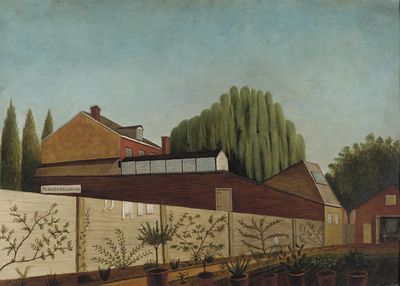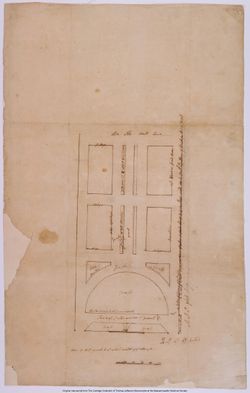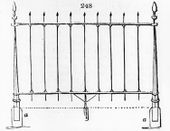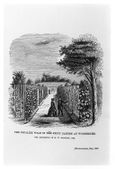Espalier
History
Espalier refers to a garden structure that was used to support plants, particularly fruit trees. Visual evidence, such as Rubens Peale’s painting of the Peale Museum in Philadelphia [Fig. 1] and the engraving of the College of Rhode Island (now Brown University) [Fig. 2], indicates that training trees against walls was practiced in America throughout the 18th and 19th centuries.[1] Written evidence also documents this practice, although these descriptions were often very brief. One must turn to treatises for detailed discussions of espaliers.

Treatises, particularly those from the 17th and 18th centuries, distinguished among at least three different types of espaliers. First, and most rare, was what Ephraim Chambers (1741) referred to as the British espalier: “rows of trees, planted regularly round the out-side of a garden, or plantation, for the general security thereof,” but notably, Chambers did not specify which type of tree. This form of barrier could be made of elm, lime, oak, or pine trees. For a shorter barrier, or the hedge espalier, Chambers recommended such trees as apple, holly, and laurel ().
In the second form of espalier, trees (and possibly shrubs) were affixed and spread against a wall, while the third, closely related form featured trees and/or shrubs that were trained on a trellis or lattice to stand as an independent hedge-like unit. Philip Miller, in The Gardeners Dictionary (1754), referred to the latter form when he explained that the “most commonly received notion of Espaliers are hedges of Fruit-trees. . . trained up regularly to Lattice of Wood-work” (view text). The walls, trellises, or lattices associated with the second and third forms provided the ideal shelter for nurturing “tender” or less hardy plants, and also established structures useful for training the growth of young plants.
If Miller’s claim about the most commonly received notion of espaliers was true of American usage (and it is likely that it was), then the discussions by 18th-century Americans of espaliers of fruit trees indicate that the trees were trained to trellises or lattices. They also indicate the possible appearance of fruit espaliers described by Thomas Hancock (1736) and Manasseh Cutler (1778), as well as those mentioned by George Washington (1785), who owned a copy of Miller’s book, and by an observer in 1800 of Adrian Valeck’s estate in Baltimore (view text).
Despite the availability of European treatises that addressed both the idea of espaliers and built examples in America, Bernard M’Mahon (1806) asserted that “some people have not a sufficient idea of what is meant by espaliers.” M’Mahon’s definition—“hedges of fruit-trees. . . trained up regularly to a lattice or trellis of wood work, and. . . commonly arranged in a single row in the borders [and]. . . boundaries. . . of the kitchen-garden”—reiterates the concepts of previous treatise writers (view text), particularly those of Miller. The fruit trees that M’Mahon referred to dominated 19th-century descriptions of espaliers, though in 1817 John Abercrombie argued that older fruit espaliers were unproductive and too formal in appearance (view text).
Throughout the 18th and 19th centuries, espaliers also served to mark divisions in the garden and to screen workplaces. The mid-18th-century plan of Rosewell, on the York River, Virginia, which reveals an alternating system of hedges and espaliers in the outlines of garden plots, illustrates the use of espaliers to enclose and separate garden divisions [Fig. 3]. Adrian Valeck also used the espalier feature as a border for the walks and squares of his garden.
To fulfill these spatial functions and to provide an environment conducive to growing, either trellises, lattice work, or rails were used to give support to trees. By the mid-19th century, the term referred to this support material, as demonstrated by Noah Webster’s 1850 definition of “espalier,” which, unlike his 1828 version, included a secondary denotation as “a lattice-work of wood, on which to train fruit-trees and ornamental shrubs” (view text).
The wide range of material used for espaliers and method of treatment was indicated in both Philip Miller’s The Gardeners Dictionary (1754) and J. C. Loudon’s An Encyclopaedia of Gardening (1826), which included specifications for simple wooden espaliers, framed wooden espalier rails, cast-iron espalier rails, horizontal espalier rails, and oblique espalier rails (view text). A. J. Downing, in his 1847 description of the fruit garden at Wodenethe, noted that the espalier used there brought fruit to greater perfection (view text). In lining the walks and providing a support structure for a single row of fruit trees, such an espalier matched the specifications of most 19th-century descriptions by American treatise writers and lexicographers.
—Anne Helmreich
Texts
Usage
- Hancock, Thomas, December 20, 1736, describing the residence of Thomas Hancock on Beacon Hill, Boston, MA (quoted in Hedrick 1988: 49)[2]
- “If you have any Particular, Curious Things not of a high price will Beautifie a flower Garden, Send a Sample with the price or a catalogue of ‘em; pray Send me a Catalogue of what Fruit you have that are Dwarf Trees and Espaliers.”
- Cutler, Manasseh, August 16, 1778, describing a garden in Rhode Island (1888: 1:68–69) [3]
- “Went in the afternoon with a number of officers to view a garden near our quarters belonging to one Mr. Bowler—the finest by far I ever saw. It is laid out much in the form of my own, contains four acres, has a grand aisle in the middle, and is adorned in the front with beautiful carvings. Near the middle is an oval, surrounded with espaliers of fruit trees, in the center of which is a pedestal, on which is an armillary sphere, with an equatorial dial. . . There are espaliers of fruit trees at each end of the garden, some curious flowering shrubs, and a pretty collection of fruit trees.”
- Washington, George, March 14, 1785, describing Mount Vernon, plantation of George Washington, Fairfax County, VA (Jackson and Twohig, eds., 1978: 4:102)[4]
- “Planted the 9 young peach Trees which I brought from Mr. Cockburns in the No. Garden—viz.—4 on the South border of the second walk (two on each side of the middle walk)—2 in the border of the Walk leading from the Espalier hedge towards the other cross walk and 3 under the South wall of the Garden; that is two on the right as we enter the gate & one on the left. The other Peachtree to answer it on that side & the two on the West Walk, parrallel to the Walnut trees were taken from the nursery in the Garden.”
- Anonymous, June 14, 1800, describing in the Federal Gazette the estate of Adrian Valeck, Baltimore, MD (quoted in Sarudy 1989: 136)[5]
- “A large garden in the highest state of cultivation, laid out in numerous and convenient walks and squares bordered with espaliers, on which. . . the greatest variety of fruit trees, the choicest fruits from the best nurseries in this country and Europe have been attentively and successfully cultivated.” back up to History

- Bryant, William Cullen, August 25, 1821, in a letter to his wife, Frances F. Bryant, describing the Vale, estate of Theodore Lyman, Waltham, MA (1975: 1:108)[6]
- “He took me to the seat of Mr. Lyman. . . It is a perfect paradise. . . A hard rolled walk, by the side of a brick wall, about ten feet in height and covered with peach and apricot espaliers which seemed to grow to it, like the creeping sumach to the bark of an elm.”
- Downing, Andrew Jackson, May 1847, “The Fruit Garden at Wodenethe,” describing Wodenethe, residence of Henry Winthrop Sargent, Dutchess County, NY (Horticulturist 1: 504)[7]
- “Our FRONTISPIECE gives a glimpse of this Vinery, at the termination of the main walk of the fruit-garden. This walk is 428 feet long, and is bordered with an espalier rail, upon which many of the choicest peaches, grapes, plums, etc., are trained—not from necessity or for greater protection, as in gardens farther north, for all those fruits ripen perfectly on common standards here, but to give an illustration of this more perfect kind of culture, and to obtain fruit of a larger size and higher color than standards usually produce.” [Fig. 4] back up to History
Citations
- La Quintinie, Jean de, 1693, The Compleat Gard’ner (1693; repr., 1982: n.p.)[8]
- “Espaliers, are Wall-trees, or any Trellissed, or palisado’d Tree.”
- Switzer, Stephen, 1718, Ichnographia Rustica (1718: 2:225–31)[9]
- “As a general Security for a Garden or Plantation against Blasting and tempestuous Winds, it is necessary to plant substantial and lofty Vegetables; these are called Espaliers, and are likewise us’d for the bounding of Borders, Walks, Avenues, &c. but most commonly for the Defense of Plants and Greens.
- “The several Sorts of Trees fit for Espaliers, are, the Dutch Witch and English Elm, the Lime, Abeal, Pine, Scotch Fir, Siccamore [sic], Beech, and Oak; but the Elms and Limes are very preferable to the others; and the Firs and Pines, next to them, deserve Place. In the Choice of these Trees, and Transplanting, great Care ought to be taken; they must be strong, and the larger the better, as they will the sooner answer your Purpose. . .
- “The wooden Frame for Espalier Hedges is necessary where the Use of those Hedges is requir’d, the first or second Year after planted. These Frames are to be made very substantial, about seven, eight, or nine Foot high; the Distance of every Post asunder, and the length of the Rails to be equal to the length of the Posts, which is commonly about eight Foot for an Espalier Frame of the same Height from the Surface of the Ground; and to this Frame there may be six Rails, each being about sixteen Inches asunder. . .
- “The Form of the Ground for Espaliers ought to be oblong; and in laying it out, the two longest parallel Sides should run North and South, or thereabouts; and as for the Extent, you are to proportion it according to the Number of the tender Greens and Plants which you design it shall receive; always allowing for proper Distances in placing them, and for Allies. The Situation ought not to be remote from the Green-house, for Convenience in removal of the Greens, forward and backward, as Seasons shall require.”
- Chambers, Ephraim, 1741, Cyclopaedia (1741: 1:n.p.)[10]
- “ESPALIER, in the French gardening, a wall-tree; or a fruit-tree, which is not left to grow at liberty in full air, but has its branches nailed or fastened to a wall, near which it is planted; and thus growing, it is made to conform it self to the flat though unnatural, figure thereof. See FRUIT-Tree, WALL, &c.
- “ESPALIERS, in our gardening, are rows of trees, planted regularly round the out-side of a garden, or plantation, for the general security thereof, from the violence and injury of the winds; or else only round some part of a garden, for the particular security of a plantation of orange trees, lemon trees, myrtles, or other tender plants; or, lastly for the bounding of borders, walks, avenues, &c. See GARDEN, &c.
- “Espaliers are now come into mighty use, with respect to the first of these intentions: in effect, it is found by experience, that the best brick, or stone walls, are not of themselves sufficient security to fruit-trees, from the ravages of blighting winds. See WALL.
- “The reason may be, that being built close and compact, they repel the winds, and by that means damage the tender plants, that lie within the reach of the repulsion. But these espaliers serve to deaden the violence of the winds, so as the tender greens, or plants, encompassed by them, rest serene and quiet.
- “Thus, if the espaliers, for instance, be of spruce holly, or yew, they give way to the fource of tempestuous winds beating against them, without occasioning any resilition thereof.
- “Mess. London and Wise, direct them to be planted at some distance, without the outmost bounds, or walls of gardens, &c. Two, or three rows of trees, they think sufficient, from 18 or 20 to 25 foot a-part. And as to the method, or order, of disposing the trees, the most commodious is where the middle row makes every where equilateral triangles with the extreme rows, in the following manner. See QUINCUNX.
- “The trees recommended for making, or planting, these espalier fences, are the elm, lime, beech, Scotch fir, oak, pine and sycamores; but particularly the two first. For the method of planting them, see PLANTING, TRANSPLANTING, &c.
- “As for espalier hedges, or hedge rows for defence of tender greens, and plants, from destructive winds in the summer season; if there be occasion to use them the first or second year after they are planted, a substantial frame of wood must be made, seven or eight foot high, with posts and rails. And to this espalier frame, must the side boughs of the young trees be tied, to cause the espalier to thicken the sooner.
- “For the form of such an espalier, it must be oblong, running north and south.—It may be planted with apples, pears, holly, laurel, lime, maple, white-thorn, yew, &c.” back up to History
- Miller, Philip, 1754, The Gardeners Dictionary (1754; repr., 1969: 476–78)[11]
- “ESPALIERS,
- “Are either Rows of Trees planted about a whole Garden or Plantation, or in Hedges, so as to inclose Quarters, or separate Parts, of a Garden, which are trained up flat in a close Hedge, for the Defence of tender Plants against the Violence and Injury of Wind and Weather. See Hedges.
- “The most commonly receiv’d Notion of Espaliers are Hedges of Fruit-trees, which are train’d up regularly to Lattice of Wood-work; formed either of Ash-poles, or square long Timbers cut out of Fir, &c. . .
- “Espaliers of Fruit-trees are commonly planted to surround the Quarters of a Kitchen-garden; for which Purpose they are of admirable Use and Beauty: for by laying out the Walks of this Garden regularly, which are bounded on each Side by these Hedges, when they are handsomely managed, they have a wonderful Effect in sheltering the Kitchen-plants in the Quarters, and also screening them from the Sight of Persons in the Walks; so that a Kitchen-garden, well laid out in this manner, and regularly managed, will be equal to the finest Parterre for Beauty.
- “The Trees chiefly planted for Espaliers are Apples, Pears, and some Plums; but the two former are mostly used. . .
- “The Width of the Walks between these Espaliers should (in a large Garden) be fourteen or sixteen Feet at least; and if they are designed to be carried up pretty high, the Distance should be greater, that each Side may receive the Advantage of the Sun and Air; which is absolutely necessary. . .
- “I shall now give Directions for making the Espalier, to which the Trees are to be trained: but this I would not have done until the third Year after the Trees are planted; for while they are young, it will be sufficient to drive a few short Stakes into the Ground on each Side of the Trees, to which the Branches should be fastened in an horizontal Position, as they are produced; which Stakes may be placed nearer, or at a farther Distance, according as the Shoots produced may require, and will be sufficient for the three first Years; for should you frame the Espalier the first Year the Trees are planted, the Poles would rot before the Espalier is covered. The cheapest Method to make these Espaliers is with Ash-poles, of which you should have two Sorts; one of the largest Size, which contains thirteen Poles in a Bundle, and the other Size those of half an Hundred: the first or largest-size Poles should be cut about seven Feet and an half long; these are intended for upright Stakes, and must be sharpened at the largest End, that they may, with more Ease, be driven into the Ground; these should be placed at a Foot Distance from each other in a direct Line, and of an equal Height, about six Feet above-ground; then you should nail a Row of trait slender Poles along upon the Tops of the upright Stakes, which will keep them exactly even, and continue to cross the Stakes with the smaller Poles, and the Tops which were cut off from the larger ones, at about nine Inches Distance, Row from Row, from the Top to the Bottom of the Stakes. These Rows of Poles should be fastened with Wire, and the largest End of the Poles should be nailed to the upright Stakes, which will secure the Espalier almost as long as the Poles will endure; whereas, if your Fastening is not strong, the Poles will be continually displaced with every strong Wind.
- “When the Espalier is thus framed, you must fasten the Branches of the Trees thereto, either with small Osier-twigs, or some such Binding, observing to train them in an horizontal Position, and at equal Distances; being careful not to cross any of the Branches, nor to lay them in too thick: the Distance I would allow for the Branches of Pears and Apples, should be proportioned according to the Size of their Fruit; such of them whose Fruit is large. . . should have their Branches six or eight Inches Distance at least; and to those of lesser Growth, four or five Inches will be sufficient. . .
- “But, besides this Sort of Espalier made with Ash-poles, there is another Sort that is by many People preferred; which is framed with square Timbers cut to any Size, according to the Strength thereof, or the Expence the Owner is willing to go to: these, tho’ they appear more sightly, when well fixed and painted, are not of longer Duration than one of the former, provided it is well made, and the Poles are strong which are set upright; nor will they answer the Purpose better, tho’ they are vastly more expensive; for the greatest Beauty consists in the disposing the branches of the Tree, which, especially in Summer, when the Leaves are on, will intirely hide from the Sight the Frame of the Espalier: therefore all Expence in erecting these is needless, farther than making Provision to secure the Branches of the Trees in a regular Order.
- “Fruit-trees thus planted, and well managed, are much preferable to those trained up in any other Figure, upon several Accounts: as first, these take up very little room in a Garden, so as to be hurtful to the Plants which grow in the Quarters; and, secondly, the Fruit upon these are better tasted than those which grow upon Dwarfs, the Sun and Air having freer Access to every Part of the Tree; whereby the Dampness arising from the Ground is sooner dissipated; which is of singular Advantage to Fruit-trees (as hath already been shewn).” back up to History
- Johnson, Samuel, 1755, A Dictionary of the English Language (1755: 1:n.p.)[12]
- “ESPA’LIER. n.s. Trees planted and cut so as to join.”
- Marshall, Charles, 1799, An Introduction to the Knowledge and Practice of Gardening (1799: 1:37)[13]
- “Espalier trees should rather be trained to sawed materials properly framed together, smoothed and painted. But for a year or two, they may be fastened to light stakes, when they will have formed a head, to begin to train them for bearing in the neat manner proposed; i. e. to slips of deal joined to light oak posts as trellises.”
- M’Mahon, Bernard, 1806, The American Gardener’s Calendar (1806: 16)[14]
- “As some people have not a sufficient idea of what is meant by espaliers, the following explanation, and instructions for forming them, &c. may not be unacceptable.
- “Espaliers are hedges of fruit-trees, which are trained up regularly to a lattice or trellis of wood work, and are commonly arranged in a single row in the borders, round the boundaries of the principal divisions of the kitchen-garden; there, serving a double or treble purpose, both profitable, useful, and ornamental. They produce large fine fruit plentifully, without taking up much room, and being in a close range, hedge-like; they in some degree shelter the esculent crops in the quarters; and having borders immediately under them each side, afford different aspects for different plants, and also they afford shelter in winter, forwardness to their south-border crops in spring, and shade in summer; and as to ornament and variety, what can be more delightful in spring, in the excursion of the walks, than the charming appearance which the trees make when covered with their showy bloom, differing in themselves, in those of different genera, species, and varieties;” back up to History
- Abercrombie, John, with James Mean, 1817, Abercrombie’s Practical Gardener (1817: 180)[15]
- “Espaliers have the branches trained to an upright superficial trellis, standing detached from a wall, and thus bear on both sides. Occupying little room, they drip and shade less than standards, but are more troublesome to manage. While young, they may be rendered in some degree ornamental; but as the plants get old, the most skilful pruning can hardly keep espaliers fruitful, or prevent them from looking formal.”
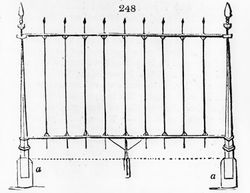

- Loudon, J. C. (John Claudius), 1826, An Encyclopaedia of Gardening (1826: 308–9)[16]
- “1576. Espalier rails are substitutes for walls, and which they so far resemble, that trees are regularly spread and trained along them, are fully exposed to the light, and having their branches fixed are less liable to be injured by high winds. They are formed of wood, cast-iron, or wire and wood.
- “1577. The wooden espalier, of the simplest kind, is merely a straight row of stakes driven in the ground at six or eight inches asunder, and four or five feet high, and joined and kept in a line at top by a rail of wood, or iron hoop, through which one nail is driven into the heart of each stake. . .
- “1578. The framed wooden espalier rail is composed of frames fitted with vertical bars at six or eight inches asunder, which are nailed on in preference to mortising, in order to preserve entire the strength of the upper and lower rails. . .
- “1579. The cast-iron espalier rail. . . resembles a common street railing, but it is made lighter. . . [Fig. 5]
- “1580. The horizontal espalier rail. . . is a frame of wood or iron, of any form or magnitude, and either detached or united, fitted in with bars, and placed horizontally, at any convenient distance from the ground. . . [Fig. 6]
- “1581. The oblique espalier rail is composed of bars, wires, or lattice-work, placed obliquely.” back up to History
- Johnson, George William, 1847, A Dictionary of Modern Gardening (1847: 214–15)[17]
- “ESPALIER, is a tree trained to a trellis instead of a wall, and though the fruit it bears is not quite equal to that borne by a tree of the same variety trained against the wall, yet it is far superior to that borne on either dwarf or full standards. Of this the causes obviously are, that the fruit and leaves are more fully supplied with sap, and more perfectly exposed to the light and warmth of the sun. Some gardeners object to their introduction into the kitchen garden on the plea that they deprive the under crops of air and light, but if confined to the borders of the main walks, the shelter they afford to those crops is more the commensurate to the slight interruption suggested. In addition, they are highly ornamental, and greatly improve the aspect of the kitchen garden. Espalier rails should run parallel with the walks, and at four feet distance from them; not higher than five feet; neat, and if made of wood, tarred, and the ends which are fixed in the ground charred; though blocks of stone sunk into the ground, with iron sockets or bases to receive those ends, are still better.
- “Gooseberries and Currants are highly improved by being trained as espaliers, and may be so grown along borders near the side walks of the kitchen garden. For these the trellis must be not higher than three feet from the ground, and for the purpose stakes about four inches in circumference, and thus arranged, are very suitable. Various suggestions have been made for altering the form of espalier trellises, but let the gardener never adopt any that declines from the perpendicular. The smallest approach to the horizontal increases the radiation of heat from the trees, and increases, consequently, the cold they have to endure at night. It is not one of the least advantages of training gooseberries and currants as espaliers, that it facilitates the protecting them with mats.”
- Webster, Noah, 1850, An American Dictionary of the English Language (1850: 409)[18]
- “ES-PAL’IER, (es-pal’yer,) n. [Fr. espalier; Sp. espalera; H. spalliera; from L. palus, a stake or pole.]
- “1. A row of trees planted about a garden or in hedges, so as to inclose quarters or separate parts, and trained up to a lattice of wood-work, or fastened to stakes, forming a close hedge or shelter to protect plants against injuries from wind or weather. Ency.
- 2. A lattice-work of wood, on which to train fruit-trees and ornamental shrubs. Brande.” back up to History
Images
Inscribed
J. C. Loudon, “The cast-iron espalier rail,” in An Encyclopaedia of Gardening (1826), 309, fig. 248.
J. C. Loudon, “The horizontal espalier rail,” in An Encyclopaedia of Gardening (1826), 309, figs. 249 and 250.
Anonymous, “The Espalier Walk in the Fruit Garden at Wodenethe,” in A. J. Downing, ed., Horticulturist 1, no. 11 (May 1847): pl. opp. 489.
Attributed
David Leonard, A S. W. view of the College in Providence, together with the President’s House & Gardens, c. 1795.
Notes
- ↑ In Peale’s Museum wires strung between the fence posts may have provided support for the espaliers. It is difficult though to determine if the dark, horizontal lines painted on the fence indicate either wires or plank divisions.
- ↑ U. P. Hedrick, A History of Horticulture in America to 1860; with an Addendum of Books Published from 1861–1920 by Elisabeth Woodburn (Portland, OR: Timber Press, 1988), view on Zotero.
- ↑ Manasseh Cutler, Life, Journals, and Correspondence of Rev. Manasseh Cutler, 2 vols., ed. William Parker Cutler and Julia Perkin Cutler (Cincinnati: Robert Clarke & Co., 1888), view on Zotero.
- ↑ Donald Jackson, and Dorothy Twohig, ed. The Diaries of George Washington, 6 vols. (Charlottesville: University Press of Virginia, 1978), view on Zotero.
- ↑ Barbara Wells Sarudy, “Eighteenth-Century Gardens of the Chesapeake,” Journal of Garden History 9, no. 3 (July–September 1989): 104–59, view on Zotero.
- ↑ William Cullen Bryant, The Letters of William Cullen Bryant, ed. William Cullen II Bryant and Thomas G. Voss (New York: Fordham University Press, 1975), view on Zotero.
- ↑ A. J. Downing, “The Fruit Garden at Wodenethe,” Horticulturist and Journal of Rural Art and Rural Taste 1, no. 11 (May 1847): 503–5, view on Zotero.
- ↑ Jean de La Quintinie, The Compleat Gard’ner, or Directions for Cultivating and Right Ordering of Fruit-gardens and Kitchen Gardens, trans. John Evelyn (1693; repr., New York: Garland, 1982), view on Zotero.
- ↑ Stephen Switzer, Ichnographia Rustica, or The Nobleman, Gentleman and Gardener’s Recreation, 1st ed., 3 vols. (London: D. Browne, 1718), view on Zotero.
- ↑ Ephraim Chambers, Cyclopaedia, or An Universal Dictionary of Arts and Sciences, 2 vols. (London: D. Midwinter et al., 1741–43), view on Zotero.
- ↑ Philip Miller, The Gardeners Dictionary (1754; repr., New York: Verlag Von J. Cramer, 1969), view on Zotero.
- ↑ Samuel Johnson, A Dictionary of the English Language: In Which the Words Are Deduced from the Originals and Illustrated in the Different Significations by Examples from the Best Writers, 2 vols. (London: W. Strahan for J. and P. Knapton, 1755), view on Zotero.
- ↑ Charles Marshall, An Introduction to the Knowledge and Practice of Gardening, 1st American ed., 2 vols. (Boston: Samuel Etheridge, 1799), view on Zotero.
- ↑ Bernard M’Mahon, The American Gardener’s Calendar: Adapted to the Climates and Seasons of the United States. Containing a Complete Account of All the Work Necessary to Be Done. . . for Every Month of the Year. . . (Philadelphia: Printed by B. Graves for the author, 1806), view on Zotero.
- ↑ John Abercrombie, Abercrombie’s Practical Gardener or, Improved System of Modern Horticulture (London: T. Cadell and W. Davies, 1817), view on Zotero.
- ↑ J. C. (John Claudius) Loudon, An Encyclopaedia of Gardening; Comprising the Theory and Practice of Horticulture, Floriculture, Arboriculture, and Landscape-Gardening, 4th ed. (London: Longman et al., 1826), view on Zotero.
- ↑ George William Johnson, A Dictionary of Modern Gardening, ed. David Landreth (Philadelphia: Lea and Blanchard, 1847), view on Zotero.
- ↑ Noah Webster, An American Dictionary of the English Language (Springfield, MA: George and Charles Merriam, 1850), view on Zotero.
